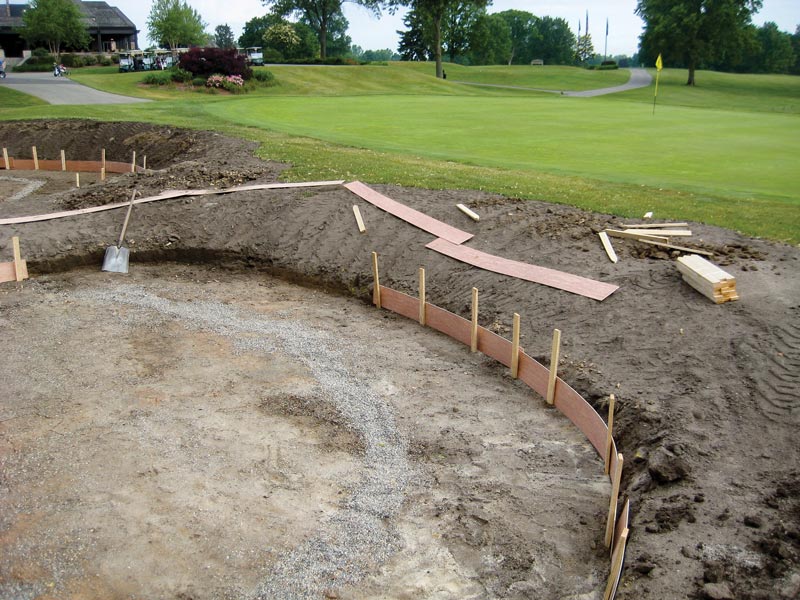
Bunkers factor prominently into the game of golf, and they typically wear out faster than other course infrastructure. Photo by Paul Severn
It has been about six years since Framingham (Mass.) Country Club’s big bunker renovation. Pat Daly, CGCS, director of golf course and grounds operations at the classic course, couldn’t be happier with how the bunkers have played and held up over that time.
“The members are really pleased with the bunkers, and I’m thrilled with them,” says Daly, who is in his 19th season at the 117-year-old club. “It’s been a home run for the club.”
And Daly will be the first to say that he and others feel that way because the club hired a reputable architect and an experienced builder to get the job done. Even though he knows Framingham’s grounds like Eric Clapton knows the frets on a guitar, Daly didn’t pretend he knew enough about architecture and construction to tell his club’s decision-makers the job could be done in-house.
“We didn’t have the people or wherewithal to do it in-house,” the 24-year GCSAA member says.
It’s a question many superintendents are faced with when planning for a bunker renovation: Should they do the work in-house, or should they hire it out? The answer may depend on a course’s specific circumstances, but there’s a lot riding on making the correct call.
Bunker work: A question of scope
Almost every superintendent faces a different situation when it comes to a bunker renovation, says Chris Clarke, president of Clarke Construction Group, a golf course builder based in Fort Myers, Fla. Clarke says deciding whether to do a bunker renovation in- or out-of-house all depends on the project’s scope. “If you are just changing the sand out, that’s something you can do in-house,” Clarke says.
But if it’s more involved than that, a course may want to consider hiring an architect and/or a builder. In some cases, only an architect may be needed; in others, just a builder. And when a project is more significant than that — such as the one at Framingham, where new bunkers were created, old ones were removed and others were renovated — involving an architect and builder may be what’s necessary to get the job done correctly.
“The scale was just too big for us,” says Daly of the bunker upgrades at Framingham. Yet Daly isn’t opposed to superintendents doing bunker renovations in-house, and knows of some superintendents who are capable of tackling even the most-involved tasks successfully. If they’re messing with a course’s design as it relates to bunkering, though, Daly suggests they hire an architect.
So does W. Bruce Matthews III, a longtime architect based in Manistee, Mich., who has designed 45 courses and renovated many more, including completing scores of bunker projects. Matthews has seen his share of golf course decision-makers play architect during bunker renovations, and the results weren’t great — water wasn’t diverted around bunkers, washouts occurred over the tops of bunkers, and newly created bunkers looked sorely out of place.
“Talk to an architect,” Matthews advises. “An architect can tell you where, why and how. And then you can go from there. Even if you’re only doing three bunkers, call an architect to show you how to do it right.”

Golf course architect W. Bruce Matthews III recently worked with Cascade Hills Country Club in Grand Rapids, Mich., and superintendent Alan Bathum, CGCS, on a bunker renovation project. Shown here is early work on a bunker on the course’s ninth hole. Photo courtesy of W. Bruce Matthews III
Even on small projects, an architect can give advice on matters such as the advantages and disadvantages of grass-faced vs. sand-faced bunkers, point out possible drainage issues, and offer an opinion on whether a bunker will require liners, Matthews says.
An architect may also know the lay of the land better than anyone else, as he or she has been trained to see it in a different way. For instance, Matthews was recently hired to plan and oversee a bunker renovation at Cadillac Country Club, a private club in northern Michigan.
“Anything north of mid-Michigan is pretty much on sand,” Matthews says, noting that water “runs right through” the course at Cadillac. Because the club didn’t have a lot of money to spend, and because the course drained so well naturally, Matthews recommended to the course’s superintendent and green committee that they not install drainage tile in the bottom of the bunkers for the time being.
Equipment, bunker longevity and other considerations
Matthews has worked on smaller projects where he was hired to make sure the design was proper and efficient, but the superintendent and the golf course maintenance crew handled the construction. In such a scenario, the facility must own or have access to an excavator and related equipment, and must have people on its crew who not only know how to operate the equipment, but also how to follow the architect’s instruction for shaping, among other things.
There are also instances where a course may want to hire a builder but not an architect, Clarke says. Maybe a course wants to improve bunker drainage and repair existing bunker faces — projects that don’t require design expertise. If the course doesn’t have the equipment or crew experience to perform such tasks, though, it should probably hire a builder, Clarke notes.
While skeptics may think Clarke and Matthews are just looking for work, the two men — who each worked for 10 years as superintendents before embarking on their current career paths — say they are more about helping superintendents save money.
“I’m not a salesperson,” Clarke says. “I don’t try to convince anybody of anything. If they ask my opinion, I will give it to them.”
Sometimes that opinion will be to hire Clarke. Same for Matthews, who says he realizes that courses’ decision-makers may be looking to save money by not hiring an architect. But they had better know what they’re doing, he advises. “They won’t be saving any money if they don’t know what they’re doing,” Matthews says.

The finished product on the ninth hole at Cascade Hills Country Club. Photo courtesy of W. Bruce Matthews III
Matthews has seen that movie a few times. Courses elect to do a bunker renovation in-house, but the people doing the renovating aren’t quite sure how to repair erosion and stop the sand from mixing with the native soil. They do their best, but their best ultimately isn’t good enough. “Even though the bunkers look better for a short period of time, they spent money they will never recoup because their bunkers aren’t going to hold up long enough,” Matthews says.
Matthews does know a “few” superintendents well-schooled in architecture who would be capable of leading a bunker renovation in-house. So does Clarke. “A lot of clubs do in-house projects, and they hire us to come in and do the specialty stuff,” Clarke says. “But their (crew members) do a lot of the heavy lifting beforehand — and they do it well and efficiently. But a lot of courses just don’t have the staff.”
Staffing matters
Ah, the staff. If courses are contemplating doing a bunker project in-house, they should keep in mind that they’ll be spreading their crew members a bit thin during the project. If four workers are assigned to a bunker renovation project, for example, that’s four fewer workers mowing greens and fairways, setting cups, and performing other normal daily maintenance tasks on the course.
“Something could suffer,” Matthews says.
So in such instances, communication is vital. The superintendent must inform the powers that be — whether that’s the owner, the green committee or the members — that balancing a bunker renovation project along with day-to-day maintenance will come at a price. And it’s the price a golf course pays in order to save money by doing the work in-house.

The bunker refresh at Cascade Hills Country Club, overseen by architect W. Bruce Matthews III, included this work on the greenside bunkers on the club’s first hole. Photo courtesy of W. Bruce Matthews III
Sometimes, a superintendent may be put in the unenviable position of being told by superiors that a bunker renovation will be done in-house, even if the superintendent knows that’s not the best idea. Clarke realizes it’s difficult for superintendents to say “no” when faced with such a predicament.
“Superintendents can be their own worst enemies, because they are wired to do more with less,” he says. “And if they have to do a project in-house, they will try to figure out a way to get it done.”
It’s a tough spot for a superintendent to be in. “You’re told to do something, and you do it, but it might not turn out so well,” Matthews says. “But it’s not the superintendent’s fault.”
So the decision on whether to do a bunker renovation in-house or to hire it out must be earnestly discussed. Egos need to be checked. Realism needs to take center stage. Everyone involved must understand the pros and cons that come along with the final decision, because once the project starts, there’s no turning back.
The right call
At Framingham, all of these things were discussed, and everyone was in agreement to hire the project out to architect Bruce Hepner and contractor Frontier Golf Course Builders. And the bunkers at Framingham haven’t looked this good and played this well in decades. They’re also holding up strong.
Recently, a summer storm “walloped” the course with rain, and a few of the bunkers were understandably washed out, Daly says. But putting the bunkers back together was as easy as a 6-inch putt.
“It took four guys about three hours,” Daly says. “(Before the renovation), it would’ve taken us two days.”
It reaffirmed for Daly that, in Framingham’s situation, the club had made the right choice.
Lawrence Aylward is a freelance writer based in Cleveland who specializes in golf course management topics. He is the former editorial director of Superintendent Magazine and the
former editor-in-chief of Golfdom magazine.